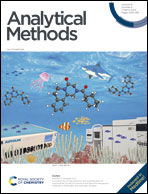A label-free activatable biosensor for in situ detection of exosomal microRNAs based on DNA-AgNCs and hairpin type nucleic acid probes†
Abstract
Exosomal microRNA (miRNA) is a potential biomarker for cancer diagnosis, metastasis, and treatment. In situ detection of exosomal miRNA is an attractive option due to its simplicity and high accuracy. However, in situ exosomal miRNA detection has encountered challenges because of the low target abundance of targets and limited probe permeability. Herein, a label-free and activatable biosensor was developed for in situ exosomal miRNA assays by utilizing hairpin-shaped nucleic acid probes and DNA-hosted silver nanoclusters (DNA-AgNCs). The probe is directly internalized into the exosomes, and then hybridized with the target miRNA-21. Subsequently, the DNA-AgNCs are pulled closer to the G-rich sequence, ultimately leading to in situ red fluorescence activation. The biosensor not only can detect exosomal miRNA-21 but also distinguish cancer cells from normal cells. Under optimal reaction conditions, the detection limit (LOD) of exosomal miRNA-21 is 1.53 × 107 particles per mL. Furthermore, DNA-AgNCs are used as label-free signal elements for in situ detection of exosomal miRNAs for the first time, expanding the application of nanomaterials in this field. This strategy does not require tedious RNA extraction steps and expensive instruments, and may develop into a non-invasive diagnostic tool for ovarian cancer.



 Please wait while we load your content...
Please wait while we load your content...